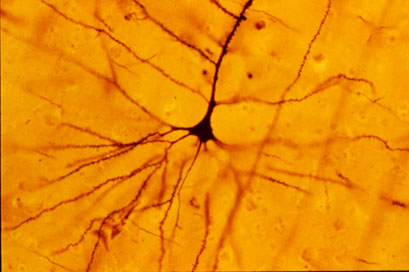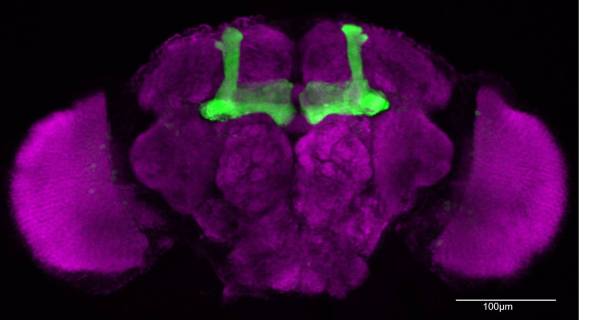New Site!
Posted by Grigori Guitchounts on April 25, 2017
https://harvardneuro.wordpress.com/2017/04/25/new-site/
I spy, I spy with my little eye
For the last couple of years I have been studying the retinal circuits of mice. While it is amazing how similar visual circuitry is among many species, I am always fascinated by surprising unique strategies that have developed in this system. The human visual system (from the retina to visual cortex) is a remarkable network that can see colors, adapt to a wide range of light intensities, perceive depth and distance, and much more. It is perfectly put-together such that each part contributes to a specific function: the lens focuses the image on the retina, different photoreceptors allow for color detection, our two frontal eyes allow for depth perception through parallax. The visual system of some animals has found other strategies to achieve the same functions, sometimes even using the same tools in new ways!
Posted by Jasmine Reggiani on December 14, 2016
https://harvardneuro.wordpress.com/2016/12/14/i-spy-i-spy-with-my-little-eye/
Sleeping on the Wing
There is an old Monty Python skit where John Cleese and Graham Chapman play airplane pilots. Presumably on a long, tedious flight, they are clearly bored and keen on amusing themselves at the expense of their passengers.
They find entertainment through relaying worrisome, nonsensical messages. Cleese begins their prank with the truism, “Hello, this is your captain speaking. There is absolutely no cause for alarm.” And after some internal discussion about what there should be no cause for alarm about, they add: “The wings are not on fire.” The messages get more ridiculous, and hilarity (at least for the pilots) ensues.
While fictional pilots can pass the time during long flights by pranking their passengers, real pilots have to find other ways to stay awake. Unless, of course, you happen to be a great frigatebird, in which case you can just sleep on the wing, as a paper published in Nature Communications this August reported. Read the full post »
Posted by Grigori Guitchounts on December 8, 2016
https://harvardneuro.wordpress.com/2016/12/08/sleeping-on-the-wing/
Shortly after the burst
Prof. Mike Greenberg talks about his research on Immediate Early Genes
Despite similarities in the numbers of genes and structure of neural circuits, primates have evolved vastly more complex brains and behaviors. What do those differences look like in the brain? A recent paper from the labs of Michael Greenberg and Margaret Livingstone at Harvard Medical School examines how a short (85 base pairs!) sequence in the regulatory region of the OSTN gene, which was previously known as a secreted protein in bone and muscle development, has allowed it to be expressed in the brains of primates, but not those of rodents. The expression of OSTN is special for another reason: it is one of the first primate-specific genes regulated by immediate early genes (IEGs) to be found. IEGs are a group of genes whose transcription in neurons is transient and commonly follows a burst of spiking activity. In their short window of expression many IEGs are known to regulate expression of specific downstream genes. The new paper from the Greenberg and Livingstone labs gives us a peak into how small differences in common molecular pathways may be implicated in the diversity of species. The journey of our knowledge and understanding of IEGs and the genetic response to neural activity is also the journey of the scientist who first observed the expression patterns of IEGs, and who has since dedicated a great deal of his scientific career to investigating them: Professor Michael Greenberg. A few weeks ago, I had the pleasure of sitting down with him to talk about his work, past, present and future.

Golgi stain of human pyramidal neuron
Posted by Jasmine Reggiani on November 11, 2016
https://harvardneuro.wordpress.com/2016/11/11/shortly-after-the-burst/
Thinking Fast and Slow about Thirst
Out of all motivational states, thirst should have been a simple one to understand. One feels thirsty when one is dehydrated, which can be detected from blood volume and osmolarity. Drinking water hydrates one’s body and quenches thirst. This is a homeostatic model. Intuitive, right? Well, the strange thing about thirst is that it is quenched within seconds to minutes after drinking water, which is too fast for any changes in the blood to happen. This is as if the brain gets hydrated before the body, which makes little sense since there is no specialized canal that passes water from mouth to brain (thank goodness). On the other hand, the buildup of the thirst drive is usually rather slow, meaning that thirst state can change on both a fast and slow time scale. How does it work?
Posted by Stephen X. Zhang on October 19, 2016
https://harvardneuro.wordpress.com/2016/10/19/thinking-fast-and-slow-about-thirst/
Consider the Fun
Scientists are often portrayed in pop-culture as pedantic types, with personalities as stiff as their starched white lab coats. While they may have a pressing work ethic and incessant care for detail, their work is creative by nature. Scientists must create knowledge by designing and building experiments. In this way, a scientist is closer to a starving artist than to an automaton.
A scientific project might be spawned from reading a paper and finding an unanswered question, or just observing a phenomenon and wondering how it happens. This stage is quite exciting – you imagine yourself doing experiments that will answer your question (or you imagine collecting data using some brand-new technique, and the results would be unlike anything anyone’s ever observed). The prospect of discovering something new is as thrilling as falling in love. Read the full post »
Posted by Grigori Guitchounts on October 12, 2016
https://harvardneuro.wordpress.com/2016/10/12/consider-the-fun/
True Beauty
“Beauty is truth, truth beauty,” – that is all
Ye know on earth, and all ye need to know.
– John Keats in ‘Ode on a Grecian Urn’
The scientific field prides itself in its objectivity. Truth is found by a search free of personal biases, personal commitments or emotional involvements. Still, a great many scientists have said beauty guided their way. For example, physicist Paul Dirac stated: “It is more important to have beauty in one’s equations than to have them fit the experiment”.
Posted by vivianhemmelder on September 26, 2016
https://harvardneuro.wordpress.com/2016/09/26/true-beauty/
As simple as random can be
A few weeks ago I was having a discussion about mathematical models for the prediction of the movements of the stock market. The question was whether there was any use to developing complex algorithms trying to predict these fluctuations. My friend (an economist) argued that while he admits the market value isn’t truly random, incorporating random variables may be the best model we have for it. It turns out that many mathematicians (and quants, economists who analyze market fluctuations using algorithms) have been using “random” models for their predictions. These range from sequences randomly drawn from log-normal distributions, to chaotic systems that may allow for the prediction of market crashes and other rare large movements. I was fascinated by the idea of randomness as a model for complex systems. It seemed particularly interesting to explore this in the context of biological processes, especially when the laws of thermodynamics have described that all physical phenomena drift towards the chaotic state of maximum entropy. Could randomness be a model for circuit wiring and function in the brain?

The Drosophila mushroom body, shown in the MB010B-GAL4 line. Courtesy of Katrin Vogt.
Posted by Jasmine Reggiani on August 21, 2016
https://harvardneuro.wordpress.com/2016/08/21/as-simple-as-random-can-be/
Keeping your head cool
During these hot summer days, lying in the shadow puffing and sweating, my arms and legs pulling down like bags of sand, it is sometimes difficult to believe that my brain is still functioning fine. How do we manage to keep our head cool, even on hot days like these?
Posted by vivianhemmelder on July 26, 2016
https://harvardneuro.wordpress.com/2016/07/26/keeping-your-head-cool/
The deciding brain and the effects of stress
 We make decisions every day. Decision-making is a way by which we exert control over our behavior, mood and even the course of our lives. One key element in decision-making is self-control. This is often seen when we have to make that extremely difficult decision between another double cheeseburger and a healthier salad. While that may seem difficult enough on its own, many decisions, such as having to choose which graduate program to join or which answer to circle on an exam, come with substantial amounts of stress. This stress can guide or compromise the decisions we make. So, how do stress and self-control come together during decision-making? What is the neurobiological basis underlying this convergence?
We make decisions every day. Decision-making is a way by which we exert control over our behavior, mood and even the course of our lives. One key element in decision-making is self-control. This is often seen when we have to make that extremely difficult decision between another double cheeseburger and a healthier salad. While that may seem difficult enough on its own, many decisions, such as having to choose which graduate program to join or which answer to circle on an exam, come with substantial amounts of stress. This stress can guide or compromise the decisions we make. So, how do stress and self-control come together during decision-making? What is the neurobiological basis underlying this convergence?
Posted by Sivapratha Nagappan on June 21, 2016
https://harvardneuro.wordpress.com/2016/06/21/the-deciding-brain-and-the-effects-of-stress/
